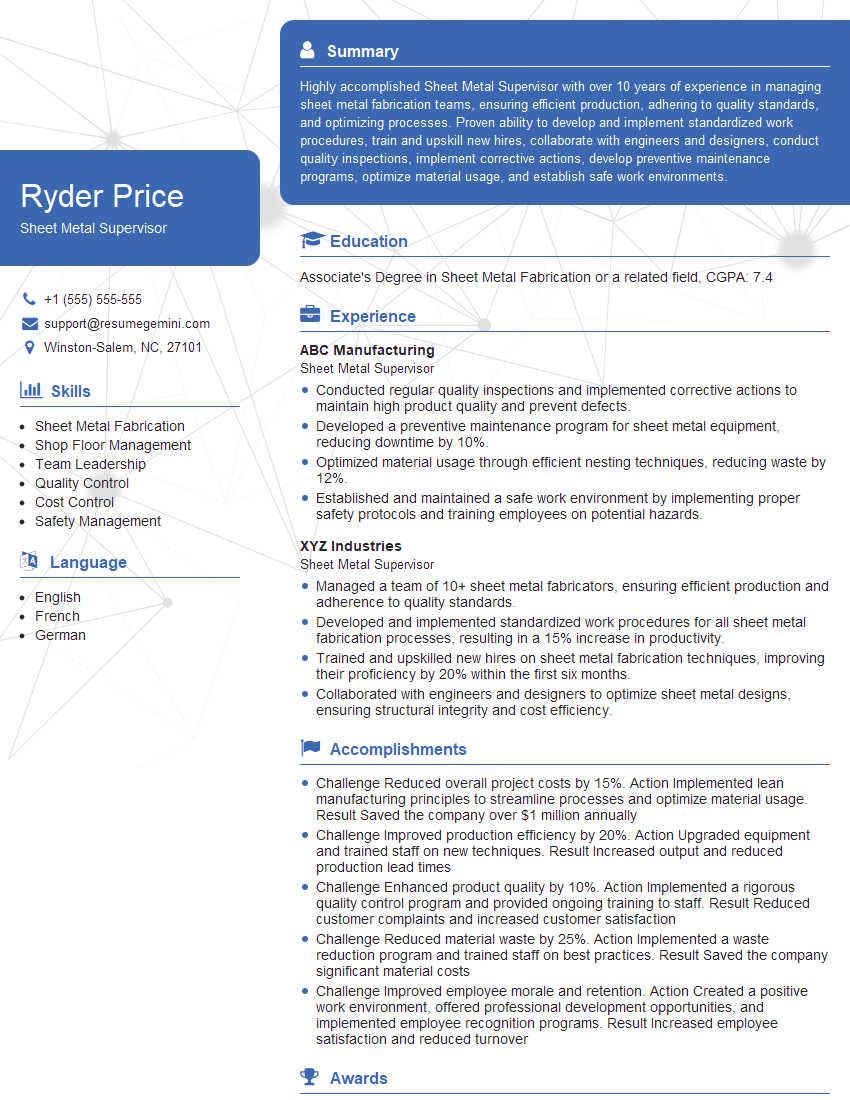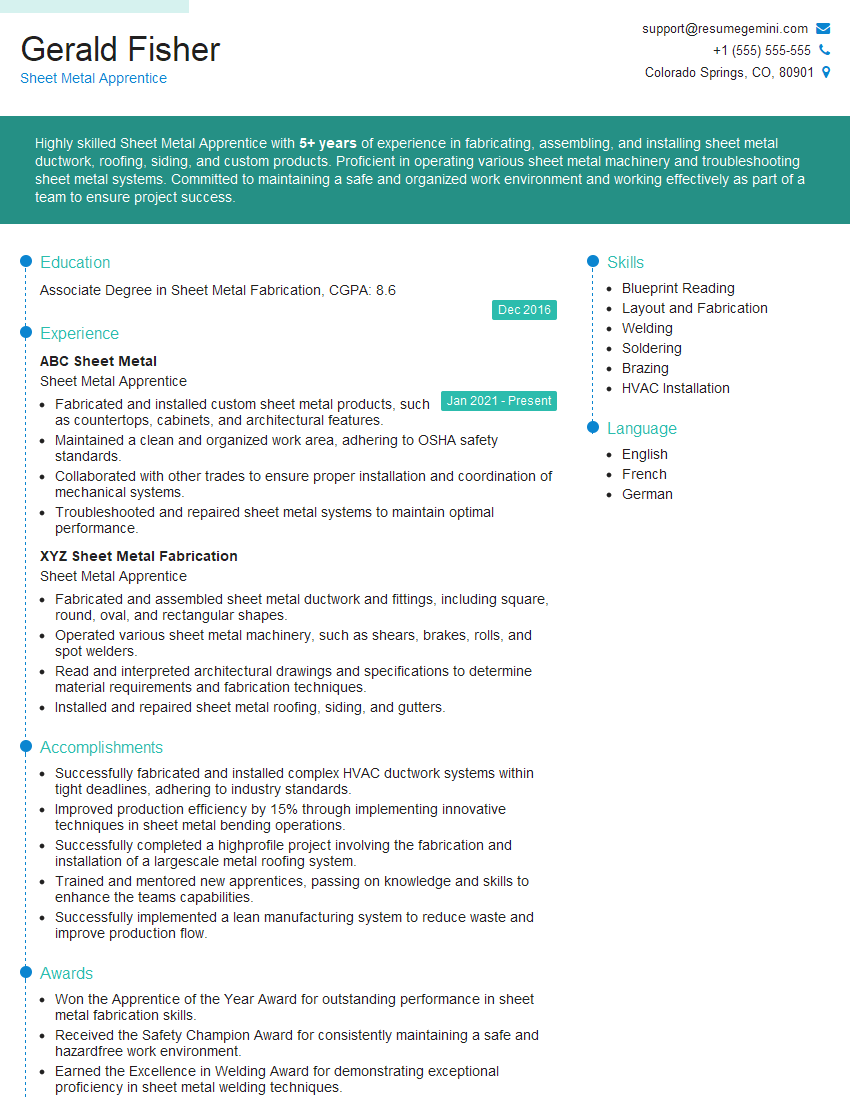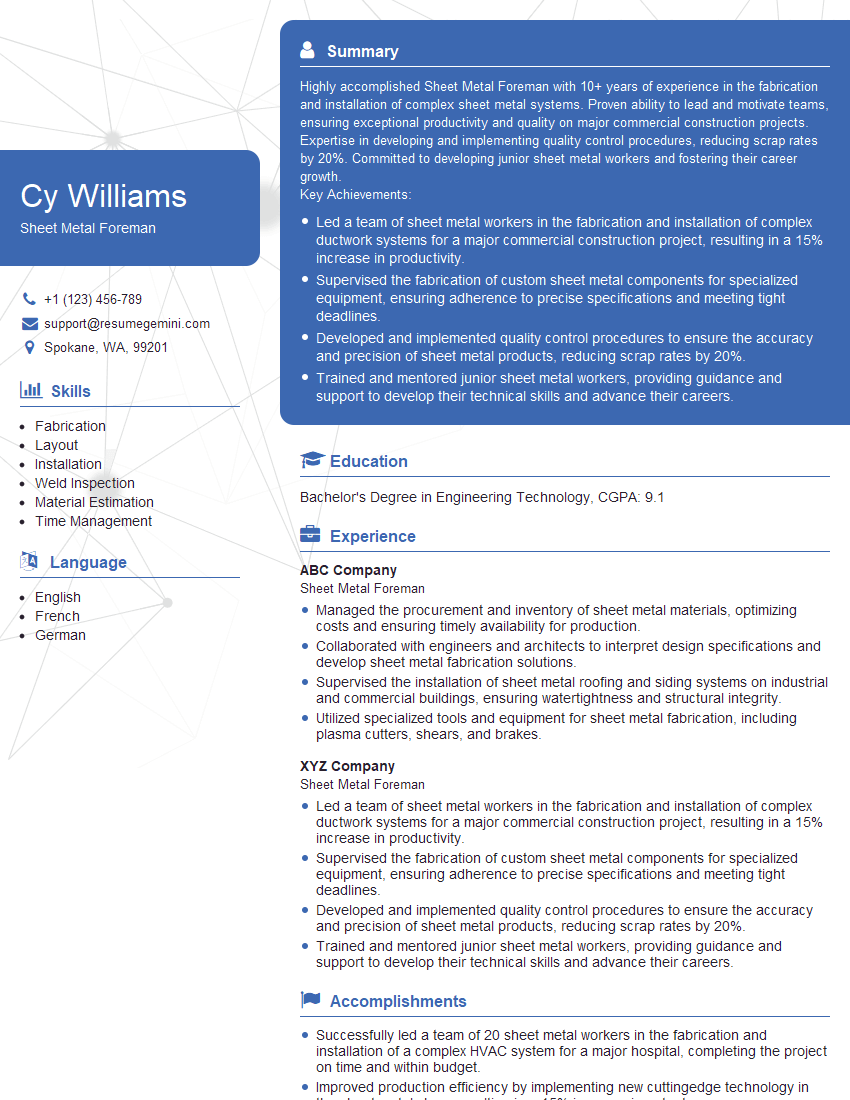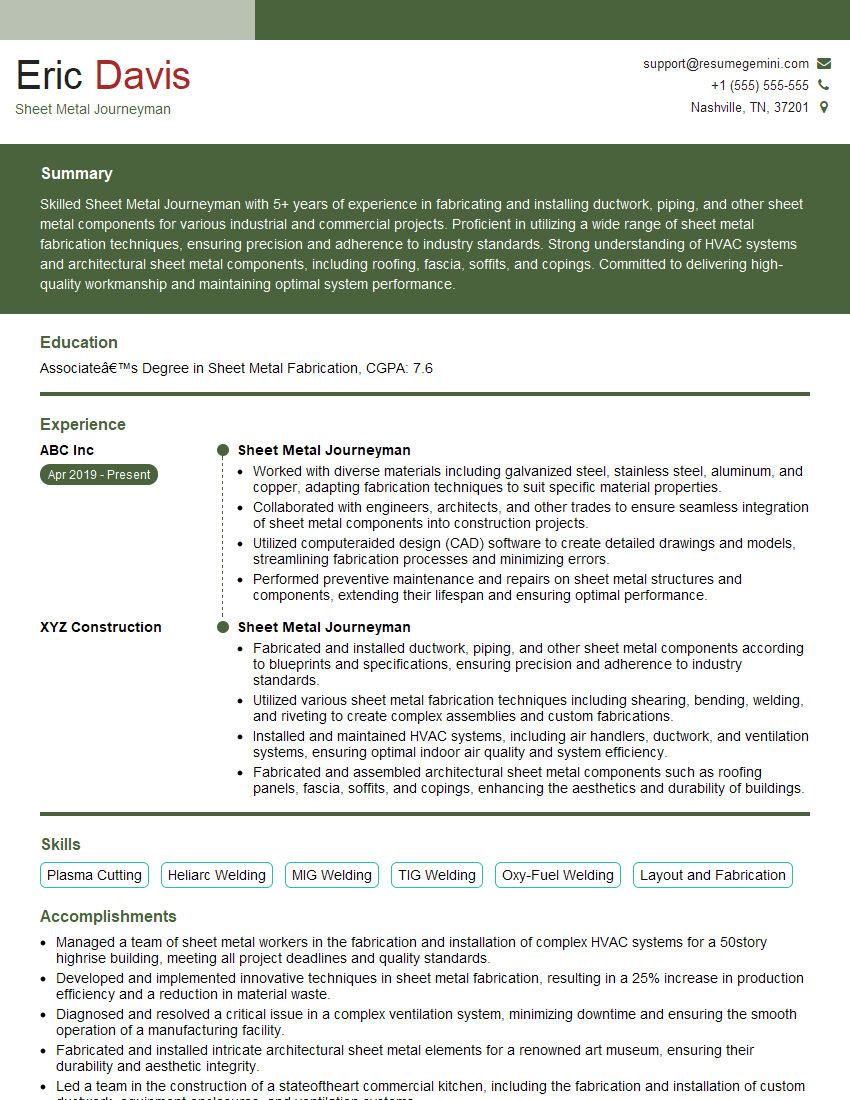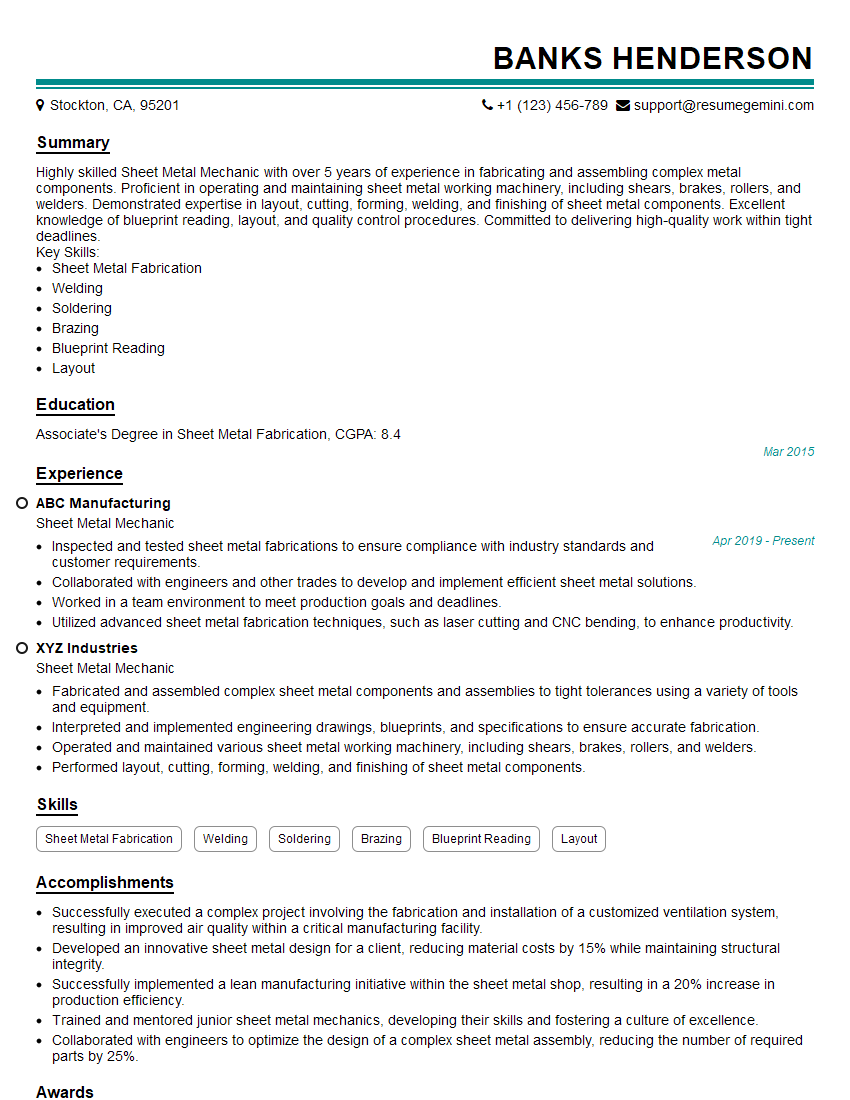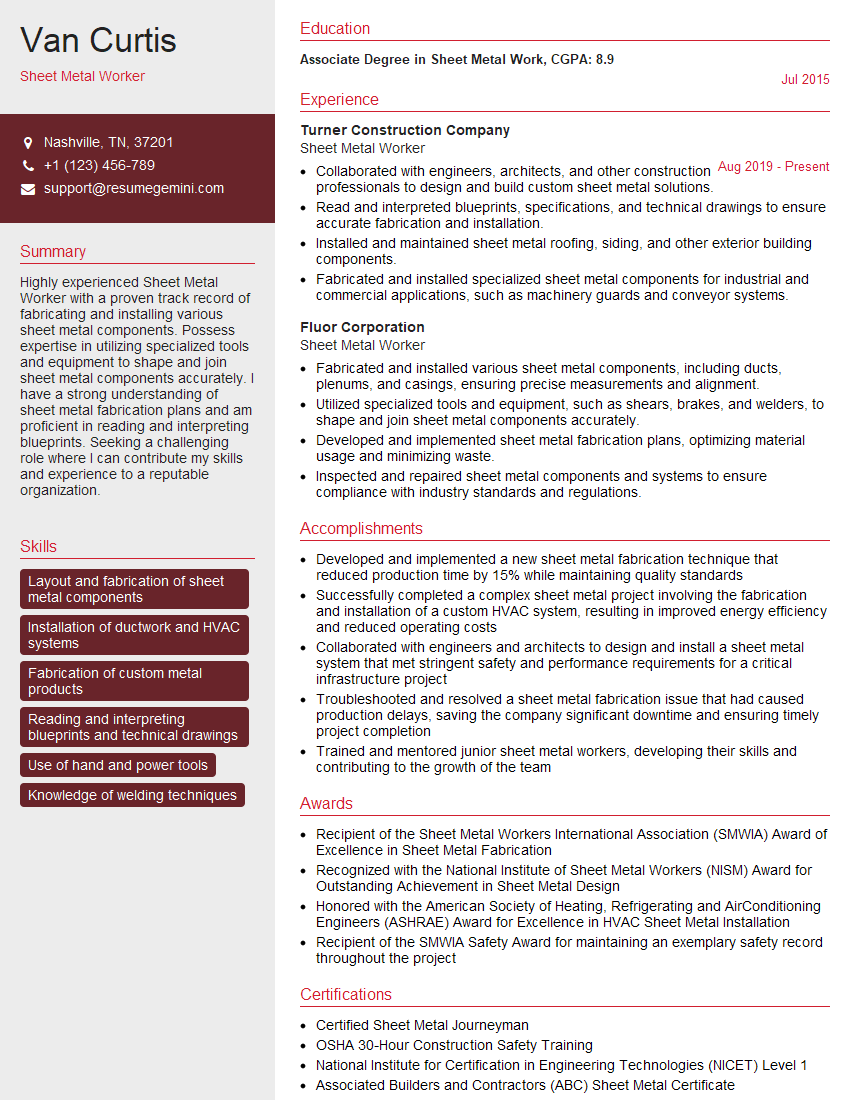Interviews are more than just a Q&A session—they’re a chance to prove your worth. This blog dives into essential Architectural Sheet Metal Fabrication interview questions and expert tips to help you align your answers with what hiring managers are looking for. Start preparing to shine!
Questions Asked in Architectural Sheet Metal Fabrication Interview
Q 1. Explain the different types of sheet metal used in architectural fabrication.
The choice of sheet metal in architectural fabrication depends heavily on the project’s requirements, including aesthetic appeal, structural integrity, durability, and budget. Several common types are used:
- Stainless Steel: Known for its corrosion resistance, strength, and sleek appearance, stainless steel is frequently used for exterior cladding, roofing, and decorative elements. Different grades (like 304 and 316) offer varying levels of corrosion resistance. For instance, 316 is preferred in coastal environments.
- Aluminum: Lightweight yet strong, aluminum is a popular choice for its formability and excellent corrosion resistance. It’s commonly seen in curtain walls, soffits, and canopies. Its lightweight nature simplifies installation.
- Galvanized Steel: A cost-effective option, galvanized steel receives a zinc coating for corrosion protection. It’s often used in less visible applications or where budget is a primary concern. However, its appearance is less refined compared to stainless steel or aluminum.
- Copper: Highly prized for its aesthetic qualities and natural weathering patina, copper is often used in high-end projects for its longevity and unique look. It’s typically found in roofing, facades, and decorative features, but its cost is significantly higher.
- Zinc: Similar to copper, zinc offers a beautiful, naturally weathering patina. Its sustainability and longevity make it a popular choice for environmentally conscious projects.
The selection process involves careful consideration of factors such as the environment, desired lifespan, budget constraints, and architectural design.
Q 2. Describe your experience with various sheet metal joining techniques (e.g., welding, riveting, soldering).
My experience encompasses a wide range of sheet metal joining techniques. The choice depends on factors such as the metal type, design complexity, and desired aesthetic finish.
- Welding: I’m proficient in various welding techniques, including Gas Metal Arc Welding (GMAW) and Gas Tungsten Arc Welding (GTAW). GMAW is faster for larger projects, while GTAW provides superior precision and control for intricate details and thinner materials. For example, I used GTAW to create seamless joints for a custom copper canopy, ensuring a clean, polished look.
- Riveting: Riveting offers a strong mechanical fastening method suitable for both joining and reinforcing. It’s less prone to heat distortion than welding and is excellent for applications where a visible fastener is acceptable. I’ve used rivets extensively in projects requiring quick and reliable assembly.
- Soldering: While less common for structural applications, soldering is invaluable for creating detailed joints and decorative elements, particularly with thinner metals. I’ve used it in custom ornamentation and for connecting smaller sheet metal components.
My expertise extends to selecting the appropriate technique and optimizing the process for each project, balancing speed, quality, and the overall aesthetic goal. I always ensure the chosen technique maintains structural integrity and meets the relevant safety standards.
Q 3. How do you ensure accurate measurements and cuts in sheet metal fabrication?
Accuracy is paramount in sheet metal fabrication. We use a combination of precise measuring tools and advanced technology to ensure accurate cuts and minimal waste.
- Laser Measuring Tools: These offer quick and accurate measurements, eliminating human error.
- CNC Cutting Machines: These machines use computer-aided design (CAD) files to guide the cutting process, ensuring extreme precision and repeatability. This drastically reduces human error compared to manual cutting.
- Layout and Marking Techniques: Before cutting, we carefully lay out the pattern on the sheet metal using precise marking tools, ensuring the parts are accurately positioned and sized. This step often involves double-checking and utilizing templates to ensure consistency.
- Regular Calibration: Our tools and machinery are routinely calibrated to maintain accuracy and prevent inconsistencies. This is critical for achieving high-quality results across multiple projects.
In my experience, a meticulous approach to measuring and cutting is fundamental to producing high-quality, error-free results that meet the architectural specifications. We treat even seemingly minor discrepancies as potential sources of major issues later on.
Q 4. What safety precautions do you take when working with sheet metal and machinery?
Safety is the top priority in our shop. We adhere to strict safety protocols and regularly conduct safety training to ensure the well-being of all personnel. Key precautions include:
- Personal Protective Equipment (PPE): This includes safety glasses, hearing protection, gloves, and appropriate clothing to protect against sparks, sharp edges, and noise. Specific PPE varies depending on the task.
- Machine Guards: All machinery is equipped with appropriate guards and safety interlocks to prevent accidental injuries. We inspect these regularly to ensure their functionality.
- Proper Lifting Techniques: Sheet metal can be heavy and awkward to handle. We employ proper lifting techniques and use mechanical aids like forklifts and overhead cranes to prevent injuries.
- Emergency Procedures: We have clearly defined emergency procedures for dealing with incidents such as fire, equipment malfunctions, or injuries. Regular fire drills are conducted.
- Housekeeping: Maintaining a clean and organized workspace significantly reduces the risk of accidents. This includes proper storage of materials and tools.
By consistently implementing these safety measures, we maintain a safe working environment and prevent accidents, fostering a culture of safety consciousness.
Q 5. Describe your experience with reading and interpreting architectural blueprints and shop drawings.
Reading and interpreting architectural blueprints and shop drawings is a crucial part of my job. My experience includes working with various drawing formats and detailing levels.
- Blueprint Interpretation: I can accurately interpret architectural drawings to understand the overall design, dimensions, and material specifications for sheet metal components. This often includes understanding complex details and sections.
- Shop Drawing Creation: I can translate architectural drawings into detailed shop drawings, including fabrication details, dimensions, and material lists. This requires a deep understanding of fabrication processes to ensure the drawings are practical and feasible.
- Detailing and Specifications: I’m skilled at interpreting specific details and specifications related to sheet metal fabrication, such as tolerances, finishes, and connections. This includes understanding the implications of different tolerances for the project.
- Coordination and Collaboration: I can effectively coordinate with architects and other trades to ensure the sheet metal work seamlessly integrates with the overall building design. This often involves clarifying ambiguities and resolving conflicts.
I have a strong track record of successfully interpreting complex architectural documentation and translating them into accurate and efficient fabrication plans, ensuring the final product aligns perfectly with the design intent.
Q 6. How do you handle material waste and optimize material usage?
Minimizing material waste and optimizing material usage are essential for cost-effectiveness and environmental responsibility. We employ several strategies:
- Nesting Software: We utilize nesting software to optimize the layout of parts on sheet metal, minimizing scrap and maximizing material utilization. This software intelligently arranges parts to reduce waste.
- Material Selection: Careful selection of sheet metal sizes and types reduces the need for excessive cutting and trimming, optimizing usage.
- Scrap Recycling: We implement a comprehensive scrap recycling program to recover and reuse usable scrap metal, reducing waste sent to landfills.
- Pre-Fabrication Planning: Thorough planning and accurate shop drawings reduce errors and the need for rework, which can generate significant scrap.
- Modular Design: Where appropriate, adopting a modular design strategy allows for prefabrication of components, resulting in greater efficiency and reduced on-site waste.
By implementing these strategies, we consistently reduce material waste, contributing to both financial savings and environmental sustainability. We actively seek ways to improve our efficiency and minimize environmental impact.
Q 7. What software programs are you proficient in for sheet metal design and fabrication (e.g., AutoCAD, SolidWorks)?
Proficiency in relevant software is crucial for efficient and accurate sheet metal design and fabrication. I am experienced with several programs:
- AutoCAD: I use AutoCAD for creating 2D drawings, drafting shop drawings, and detailing sheet metal components. I’m adept at creating precise dimensions and annotations.
- SolidWorks: SolidWorks allows for 3D modeling, enabling me to create realistic models of sheet metal components, analyze their design, and identify potential issues before fabrication. This offers a significant advantage in complex projects.
- SheetCAM/Other CAM Software: I’m also proficient with CAM software, which helps generate CNC cutting paths from 2D or 3D models. This ensures efficient and accurate CNC cutting operations.
My proficiency in these software packages allows me to efficiently design, analyze, and manufacture complex sheet metal components, ensuring a high degree of accuracy and precision.
Q 8. Explain your experience with different types of sheet metal finishes and coatings.
Sheet metal finishes and coatings are crucial for both aesthetics and the longevity of a fabricated piece. My experience encompasses a wide range, from basic to highly specialized options. Let’s explore some key examples:
- Powder Coating: A durable and versatile finish offering excellent color retention and resistance to corrosion. I’ve used this extensively on exterior cladding projects, where it provides exceptional protection against the elements.
- Liquid Coatings (e.g., polyurethane, acrylic): These offer a smoother, higher-gloss finish compared to powder coating. I’ve specified liquid coatings for interior applications where a more refined aesthetic is desired, like custom-fabricated elevator cabs.
- Anodizing (for aluminum): This electrochemical process creates a hard, protective oxide layer on aluminum, enhancing its durability and offering a range of colors. This is a go-to choice for projects requiring high corrosion resistance, such as architectural features near coastal areas.
- Galvanizing (for steel): A cost-effective method of protecting steel from rust through a zinc coating. I frequently use galvanized steel for components exposed to harsh environments, but often specify a topcoat for enhanced aesthetics.
- Kynar 500® and Hylar 5000® coatings (Fluoropolymers): High-performance coatings known for exceptional color and gloss retention, along with outstanding resistance to UV degradation and chemicals. These are reserved for premium architectural projects demanding the highest levels of durability and longevity.
Choosing the right finish involves careful consideration of the project’s location, intended use, budget, and aesthetic requirements. I always work closely with clients to select the optimal option.
Q 9. How do you ensure the quality and precision of your work?
Quality and precision are paramount in sheet metal fabrication. My approach involves a multi-faceted strategy:
- Precise Measurement and Cutting: I utilize laser cutting technology for superior accuracy and repeatability, ensuring components fit together perfectly. Manual cutting is only used when absolutely necessary and involves meticulous hand work with precise measuring tools.
- Rigorous Quality Control Checks at Each Stage: From material inspection to the final assembly, we conduct thorough checks using calibrated measuring tools and advanced inspection techniques. This minimizes errors and ensures consistency.
- Advanced Fabrication Equipment: We utilize state-of-the-art equipment such as CNC press brakes, roll formers, and punch presses to deliver consistently precise bends, rolls, and holes. This ensures precise dimensions and reduces potential for human error.
- Experienced and Skilled Workforce: Our team comprises highly skilled and experienced professionals who are rigorously trained in sheet metal fabrication techniques. Regular training on new techniques and equipment ensures continued proficiency.
- Documentation and Traceability: Detailed documentation is maintained throughout the entire process, allowing us to trace any component back to its origin and manufacturing process. This is vital for quality control and troubleshooting.
This comprehensive approach enables us to deliver high-quality sheet metal products that meet or exceed client expectations and industry standards.
Q 10. Describe a challenging project you faced and how you overcame it.
One particularly challenging project involved the fabrication of a complex, double-curved facade for a modern museum. The design called for intricate perforations and a seamless integration of lighting elements. The challenge stemmed from the difficulty in accurately forming the double curvature, maintaining consistent perforation patterns across the entire surface, and ensuring water tightness of the final structure.
To overcome these obstacles, we employed a combination of advanced techniques:
- 3D Modeling and Simulation: We created a detailed 3D model to simulate the forming process and identify potential issues beforehand.
- Custom Tooling: We designed and fabricated custom tooling for the press brake to accurately bend the panels to the required double curvature.
- Iterative Prototyping: We built several prototypes to test the forming process, perforation patterns, and the sealing of the lighting elements, allowing us to refine the design and techniques before full-scale production.
- Collaborative Approach: Close collaboration with the architect, engineers, and lighting designers ensured that everyone was on the same page and that design changes were communicated efficiently.
Through meticulous planning, advanced technologies, and a collaborative approach, we successfully completed the project to the client’s complete satisfaction, demonstrating the capability to tackle complex and demanding projects.
Q 11. Explain your understanding of different types of sheet metal gauges and their applications.
Sheet metal gauges refer to the thickness of the metal sheet. Lower gauge numbers represent thicker metal, while higher numbers indicate thinner metal. The choice of gauge depends on the application and required strength and durability. Here are some common examples:
- 24 Gauge: Commonly used for lighter-duty applications, such as ductwork in HVAC systems or decorative elements where strength isn’t paramount.
- 18 Gauge: A more common gauge for general architectural applications, providing a good balance between strength and workability.
- 16 Gauge: Used for applications requiring more strength and rigidity, such as structural components or exterior cladding in high-wind areas.
- 12 Gauge: Used for heavy-duty applications where maximum strength and durability are required, such as industrial equipment.
Selecting the appropriate gauge is critical for structural integrity, cost-effectiveness, and meeting project specifications. I always ensure the correct gauge is selected based on the project’s demands and applicable building codes.
Q 12. How familiar are you with building codes and regulations related to sheet metal fabrication?
I am very familiar with building codes and regulations related to sheet metal fabrication, including those concerning fire safety, structural integrity, and weather resistance. This knowledge is crucial to ensure our projects comply with all relevant standards and regulations. My familiarity extends to IBC (International Building Code), local building codes (which can vary significantly), and specific standards relating to material specifications and installation.
I regularly consult these codes during the design and fabrication process, and ensure our designs meet the requirements for things like:
- Fire Resistance Ratings: Selecting appropriate materials and designs to meet required fire ratings for different building components.
- Wind Load Resistance: Ensuring that exterior cladding can withstand the expected wind loads in a particular location.
- Waterproofing and Sealing: Implementing proper techniques to prevent water damage.
- Seismic Considerations: Designing structures that can withstand seismic activity in high-risk areas.
Staying updated on the latest codes and regulations is a continuous process, and we utilize industry resources and professional development to maintain our compliance expertise.
Q 13. Describe your experience with different types of metal forming processes (e.g., bending, rolling, punching).
My experience encompasses a wide range of metal forming processes, each suited to different applications and desired outcomes.
- Bending: This involves shaping sheet metal using a press brake. I’m proficient in various bending techniques to create accurate angles and complex shapes. This is fundamental for creating components with precise angles, like ductwork or building panels.
- Rolling: This process is used to create curves and cylindrical shapes. We utilize roll formers for consistent and precise curves, often employed for large-scale projects needing repetitive elements. This is vital in creating curved roofing elements or architectural features.
- Punching: This involves using a punch press to create holes or other shapes in the sheet metal. This is frequently used for ventilation holes, drainage features, or decorative patterns. Laser cutting often provides superior precision for complex shapes.
- Spinning: A process to form axisymmetric parts by rotating a sheet metal blank against a rotating tool. Less commonly used in architectural applications, but useful for creating certain custom shapes.
- Stamping: Using dies to create precise shapes and features; essential for mass production of standard components.
Choosing the right forming process is crucial for efficiency and the desired outcome. My ability to select and execute the appropriate technique is central to my expertise.
Q 14. How do you manage a project timeline and deadlines?
Project timeline management is a crucial aspect of successful sheet metal fabrication. My approach involves a structured and proactive strategy:
- Detailed Project Planning: We begin with a comprehensive plan that clearly defines all tasks, deadlines, and resource requirements. This includes a detailed breakdown of the fabrication process, material procurement, and quality control steps.
- Critical Path Analysis: Identifying the critical path – the sequence of tasks that determines the overall project duration – allows for proactive resource allocation and potential problem identification.
- Regular Progress Monitoring: Consistent progress monitoring using project management software and regular team meetings helps track performance against the planned schedule and allows for timely adjustments.
- Effective Communication: Open and transparent communication with the client and the project team is crucial for addressing potential delays or changes to the project scope.
- Contingency Planning: Incorporating buffer time into the schedule accounts for unforeseen delays or potential issues.
By using these methods, I ensure projects are completed on time and within budget, delivering high-quality results that meet client expectations.
Q 15. Describe your experience with working in a team environment.
Throughout my career, I’ve consistently thrived in collaborative team environments. I believe effective teamwork is the cornerstone of successful project completion in sheet metal fabrication. On numerous occasions, I’ve led teams, coordinating efforts between designers, fabricators, installers, and clients. For example, on a recent large-scale museum project involving intricate metalwork, I successfully managed a team of eight, ensuring all aspects – from design review to final installation – ran smoothly and to schedule. My approach focuses on clear communication, delegating tasks based on individual strengths, and fostering a supportive atmosphere where everyone feels comfortable contributing ideas and addressing concerns. This collaborative spirit avoids potential conflicts, resulting in higher quality work and improved project timelines.
I value open communication and actively encourage team members to share their expertise and perspectives. I’m comfortable both leading and supporting, adapting my role to meet the team’s needs. A successful team, in my experience, isn’t just about completing the tasks, but about creating a positive and productive environment where everyone feels valued and empowered.
Career Expert Tips:
- Ace those interviews! Prepare effectively by reviewing the Top 50 Most Common Interview Questions on ResumeGemini.
- Navigate your job search with confidence! Explore a wide range of Career Tips on ResumeGemini. Learn about common challenges and recommendations to overcome them.
- Craft the perfect resume! Master the Art of Resume Writing with ResumeGemini’s guide. Showcase your unique qualifications and achievements effectively.
- Don’t miss out on holiday savings! Build your dream resume with ResumeGemini’s ATS optimized templates.
Q 16. What are the common problems encountered during sheet metal installation?
Sheet metal installation presents several common challenges. One frequent issue is dimensional inaccuracies stemming from inconsistent site measurements or fabrication errors. Even slight discrepancies can cascade through the entire installation process, resulting in misaligned panels or gaps in the finished work. Another problem is dealing with unexpected on-site conditions. For instance, existing structures may not be perfectly square or plumb, requiring adjustments to the metalwork that weren’t accounted for in the initial plans. Weather conditions, especially extreme temperatures, can also impact installation, potentially causing warping or delays. Poor quality materials, improper handling during transportation, and inadequate safety precautions during installation can also lead to complications and project delays.
Lastly, coordinating with other trades is critical. Delays or scheduling conflicts with electricians, plumbers, or other contractors can cause significant holdups in the installation process. Think of building a jigsaw puzzle – if one piece is incorrect or missing, the whole thing suffers. In sheet metal installation, all components need to fit perfectly together, and effective coordination ensures this seamless integration.
Q 17. How do you troubleshoot issues that arise during fabrication or installation?
Troubleshooting in sheet metal fabrication and installation requires a systematic and methodical approach. My first step involves careful observation to pinpoint the exact nature of the problem. Is it a fabrication error, an installation issue, or something else entirely? I then review the original blueprints and specifications to ensure alignment with the existing work. If discrepancies exist, I document them thoroughly, and if necessary consult with the design team. For fabrication errors, determining the source – whether it’s a machine malfunction, a tooling problem, or a human error – is key. Often, a simple recalibration of a machine or a slight adjustment in the cutting process resolves the issue.
If the issue is installation related, I’d investigate the structural integrity of the supporting framework and verify that all components are correctly aligned. Solutions might range from minor adjustments to the mounting system to more significant rework, depending on the severity of the problem. I always prioritize safety, employing appropriate safety measures and following best practices. Documenting the issue, the troubleshooting steps, and the resolution is critical for future reference and continuous improvement. It’s akin to diagnosing a medical issue – careful observation, a systematic check of potential causes, and documentation of the treatment and recovery process is vital.
Q 18. Explain your understanding of different types of fasteners used in sheet metal construction.
The choice of fasteners in sheet metal construction depends significantly on the application, material properties, and aesthetic considerations. Common types include rivets, screws, bolts, and welds. Rivets are widely used for permanent joining, particularly where strength and durability are essential. They’re ideal for applications where vibration or stress is expected, as seen in aircraft construction, a field that’s closely related to sheet metal practices. Screws provide a more flexible solution, allowing for disassembly and adjustments. They come in a variety of materials and finishes, offering design versatility. For example, self-tapping screws are commonly used in thinner gauge materials, while machine screws paired with nuts and washers offer greater strength and adjustability.
Bolts are used where high strength or the need for disassembly is paramount, for instance, securing large panels or components. Welding creates a permanent and strong joint, but requires specialized equipment and skill. The choice is dictated by factors like the material thickness, anticipated loads, and the required aesthetic finish. For example, exposed screws might be preferred for a visible, industrial look, while hidden fasteners might be preferred for cleaner, architectural designs. Selection should always consider factors like corrosion resistance, material compatibility, and overall project aesthetics.
Q 19. Describe your experience with using various hand tools and power tools.
My experience encompasses a wide range of both hand tools and power tools commonly used in sheet metal fabrication. Hand tools, such as tin snips, shears, hammers, punches, and files, are essential for precise cutting, shaping, and finishing. They allow for intricate work and are invaluable when dealing with tight spaces or complex geometries. For instance, using a specialized brake to bend metal sheet to a precise angle is crucial for achieving the intended design. Power tools significantly enhance efficiency and productivity. These include sheet metal shears, power punches, drills, and various types of saws (circular, band, and jigsaw) for efficient cutting of different sheet metal thicknesses and profiles.
Welding equipment, including stick welders, MIG welders, and TIG welders, is indispensable for joining sheet metal components. Understanding the capabilities and limitations of each tool is crucial. For example, I’ve used plasma cutters for quickly cutting thicker materials, achieving clean and precise cuts; while a nibbler would be more appropriate for thinner materials where a smooth cut is required. Safe operation and regular maintenance of these tools are paramount to prevent accidents and ensure accurate results, as neglecting such would pose significant safety hazards.
Q 20. How do you maintain and care for your tools and equipment?
Maintaining tools and equipment is paramount for safety and productivity. Regular cleaning is a basic but essential step, removing debris and preventing corrosion. Lubrication of moving parts is crucial for extending tool lifespan and preventing damage. I meticulously inspect tools for damage before each use, checking for cracks, wear, or loose parts. Power tools require more involved maintenance, including checking electrical cords and connections, ensuring that safety guards are in place and functional, and replacing worn parts as necessary. Sharp cutting edges on tools like shears and snips are maintained via sharpening, a process which is integral for maintaining accuracy and safety.
Proper storage is also important. Tools are stored in designated areas, keeping them organized and protected from damage or theft. Power tools are stored in a clean, dry environment, preventing corrosion and accidental damage. Following the manufacturer’s recommended maintenance schedules ensures optimal performance and longevity. This proactive maintenance approach minimises downtime and ensures consistent accuracy and safety, which is paramount in the high-precision world of sheet metal fabrication.
Q 21. Explain your experience with quality control procedures in sheet metal fabrication.
Quality control is integral throughout the entire sheet metal fabrication process, from design review to final installation. I strictly adhere to established quality standards, ensuring that materials meet the specified requirements. Accurate measurements are verified at each stage, minimizing errors that could arise during cutting, forming, and welding. Visual inspections are performed at each step, ensuring that the work meets the standards for accuracy, fit, and finish. Using templates and jigs helps to maintain dimensional accuracy and consistency across multiple components. This methodology ensures all pieces are consistently fabricated and maintain their integrity throughout the process.
Advanced quality control measures include using precision measuring instruments and regularly calibrating equipment to maintain accuracy. Documentation of each stage is vital, allowing for traceability and problem-solving should any defects arise. For instance, detailed photographs and records are kept of every stage of the process, which aids significantly in troubleshooting any issues and helps in future reference. A rigorous quality control system results in high-quality products, minimises rework, and ultimately enhances client satisfaction and project success. It’s a continuous process, not just a final check, reflecting a commitment to excellence.
Q 22. How do you handle customer requests and modifications during a project?
Handling customer requests and modifications is crucial for project success in sheet metal fabrication. My approach is built on clear communication, meticulous documentation, and a proactive problem-solving strategy. First, I ensure I completely understand the request, asking clarifying questions to avoid misunderstandings. We then meticulously document the modification – including drawings, specifications, and any impact on the project timeline and budget. This documentation is shared with the customer for approval before proceeding. For example, if a customer requests a change in the design of a complex facade panel, I’d create a revised shop drawing highlighting the alteration, specifying the materials, and estimating the cost and time implications. This ensures transparency and avoids costly surprises later. If the change impacts other aspects of the project, I coordinate with the relevant teams (design, production, and installation) to manage the necessary adjustments smoothly.
In cases where modifications are substantial, I work with the customer to explore alternative solutions that achieve their goals while minimizing disruption and extra costs. For example, if a requested change would require a significant redesign, I might propose a slightly different approach that meets the customer’s needs more efficiently. Throughout the process, I maintain consistent communication, updating the client regularly on the progress and any challenges encountered.
Q 23. What are your salary expectations?
My salary expectations are in line with the industry standard for a senior sheet metal fabrication professional with my experience and skill set. I am flexible and open to discussion based on the comprehensive compensation package offered, including benefits and opportunities for professional development. I’m more interested in a role that provides growth potential and the chance to contribute to innovative projects than a specific salary figure. However, I have researched the market rates for similar positions and am confident in presenting a competitive expectation.
Q 24. Why are you interested in this position?
I am highly interested in this position because of [Company Name]’s reputation for excellence in architectural sheet metal fabrication and its commitment to innovative design and sustainable practices. I’ve been consistently impressed by your work on [mention a specific project or company achievement], and I believe my skills and experience align perfectly with your team’s needs. I am particularly excited about the opportunity to contribute to projects like [mention a specific type of project or technology that excites you]. The chance to work with a team that values precision, quality, and client satisfaction is particularly appealing to me.
Q 25. What are your strengths and weaknesses?
One of my greatest strengths is my problem-solving ability. I thrive in challenging situations, approaching them systematically and finding creative solutions. For example, I once encountered a significant design flaw in a complex ventilation system during the fabrication phase. Instead of panicking, I collaborated with the design team and found a cost-effective solution that ensured the project’s timely completion without compromising quality. My attention to detail is another key strength – crucial in sheet metal fabrication where even minor inaccuracies can have significant consequences. I meticulously review every step, from design to installation.
A weakness I’m working on is delegating tasks effectively. I tend to be very hands-on, but I recognize the importance of empowering team members and fostering their growth. To improve this, I’ve been actively participating in leadership training and consciously focusing on assigning responsibility and trusting others with their tasks, always providing support and guidance when needed.
Q 26. Where do you see yourself in 5 years?
In five years, I envision myself as a respected leader within the sheet metal fabrication industry, contributing significantly to [Company Name]’s continued success. I aspire to take on more responsibility, perhaps managing projects or mentoring junior team members. I’m particularly interested in expanding my knowledge of advanced fabrication techniques and sustainable materials. I am also keen to stay at the forefront of technological advancements within the industry, exploring how innovations like BIM modeling and automated fabrication processes can enhance efficiency and precision.
Q 27. Describe your experience with different types of sheet metal roofing systems.
My experience encompasses a wide range of sheet metal roofing systems, including standing seam, corrugated, batten-seam, and metal shingles. I’m proficient in working with various metals, such as aluminum, copper, stainless steel, and zinc, understanding their properties and applications. For example, I’ve worked extensively on standing seam roof installations, using concealed fastening systems to create a sleek, watertight finish. I’ve also worked on projects involving complex curved roofing profiles, requiring precise fabrication techniques and careful attention to detail to ensure structural integrity. My experience extends to understanding different fastening methods, insulation techniques, and the importance of proper ventilation within the roofing system, essential for longevity and energy efficiency.
I am also familiar with various flashings and detailing techniques crucial for preventing water ingress around penetrations, valleys, and ridges. Furthermore, I am experienced in the installation and maintenance of various accessories like snow guards, gutters, and downspouts, complementing the overall roof system. I have successfully completed projects involving different roofing styles and scales, from small residential applications to large-scale commercial projects.
Q 28. How familiar are you with sustainable practices in sheet metal fabrication?
Sustainable practices are integral to modern sheet metal fabrication, and I am very familiar with them. My experience includes working with recycled metals, reducing waste through optimized design and fabrication processes, and selecting energy-efficient materials. I’m knowledgeable about the environmental impact of different metals and finishing processes, and I prioritize minimizing our environmental footprint. For instance, I’ve utilized software to optimize material usage, minimizing scrap and reducing waste sent to landfills. I’m also well-versed in the use of low-VOC (Volatile Organic Compound) coatings to reduce air pollution and improve indoor air quality. I actively seek opportunities to implement sustainable strategies in projects, including the selection of recycled and recyclable materials and the use of energy-efficient insulation techniques.
Further, I’m aware of LEED (Leadership in Energy and Environmental Design) certification requirements and how sheet metal fabrication can contribute to achieving points in different categories. Understanding and implementing these sustainable practices isn’t just good for the environment; it also enhances the overall value and appeal of the projects we undertake.
Key Topics to Learn for Architectural Sheet Metal Fabrication Interview
- Blueprint Reading and Interpretation: Understanding architectural drawings, including dimensions, specifications, and details related to sheet metal components.
- Material Selection and Properties: Knowledge of various sheet metal types (stainless steel, aluminum, copper, etc.), their properties, and suitability for different applications. Practical application includes selecting the optimal material for a specific project based on cost, durability, and aesthetic requirements.
- Fabrication Processes: Familiarity with different fabrication techniques like shearing, punching, bending, rolling, welding (including different welding types), and finishing processes.
- Layout and Design: Understanding the principles of sheet metal layout, including nesting and minimizing material waste. Practical application: Designing efficient layouts to reduce material costs and improve production efficiency.
- Manufacturing Techniques and Equipment: Knowledge of various sheet metal fabrication machinery (press brakes, shears, lasers, etc.) and their operation. Understanding the limitations and capabilities of each machine is crucial.
- Quality Control and Inspection: Understanding industry standards and best practices for quality control, including inspection techniques to ensure the finished product meets specifications. Problem-solving: Identifying and rectifying defects during the fabrication process.
- Safety Procedures and Regulations: Familiarity with OSHA regulations and safety protocols related to sheet metal fabrication, including personal protective equipment (PPE) and safe operating procedures.
- Project Management and Cost Estimation: Understanding project timelines, material costs, labor costs, and profit margins. Practical application: Creating accurate cost estimations for projects.
Next Steps
Mastering Architectural Sheet Metal Fabrication opens doors to a rewarding career with excellent growth potential. You can advance to supervisory roles, specialized fabrication techniques, or even project management. To significantly boost your job prospects, focus on creating an ATS-friendly resume that highlights your skills and experience effectively. ResumeGemini is a trusted resource that can help you build a professional and impactful resume. They provide examples of resumes tailored to Architectural Sheet Metal Fabrication to guide you, ensuring your qualifications shine.
Explore more articles
Users Rating of Our Blogs
Share Your Experience
We value your feedback! Please rate our content and share your thoughts (optional).
What Readers Say About Our Blog
This was kind of a unique content I found around the specialized skills. Very helpful questions and good detailed answers.
Very Helpful blog, thank you Interviewgemini team.
